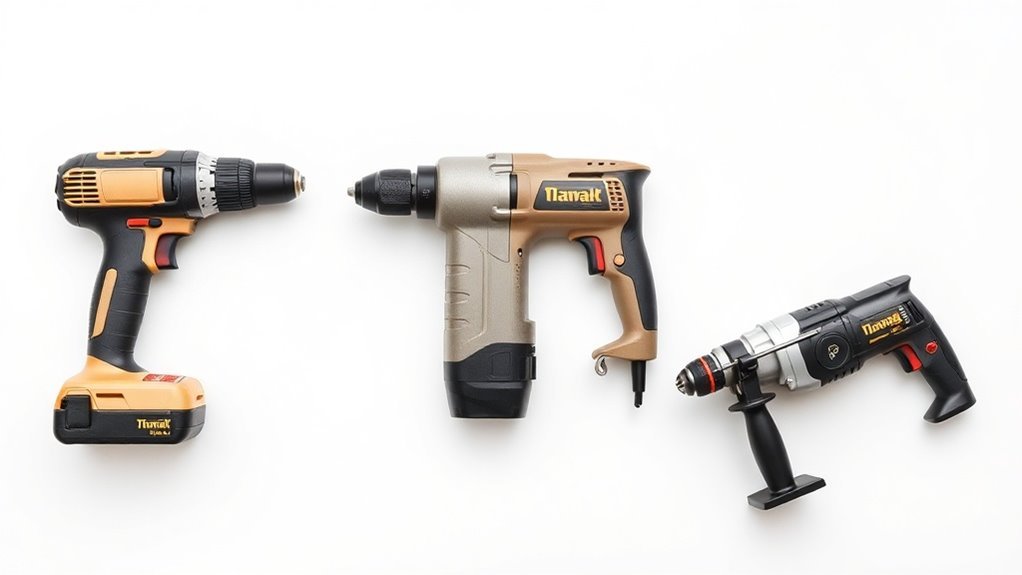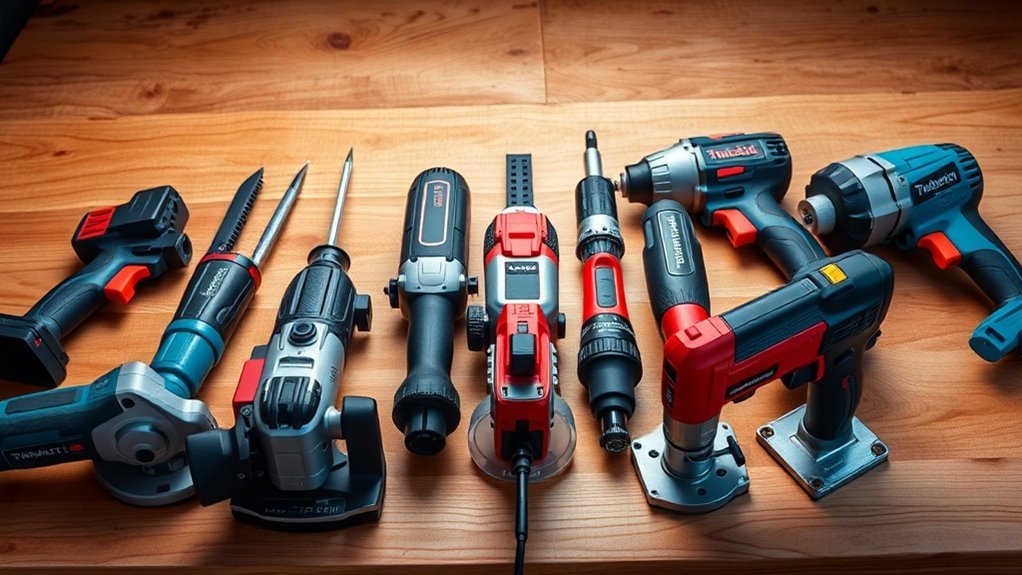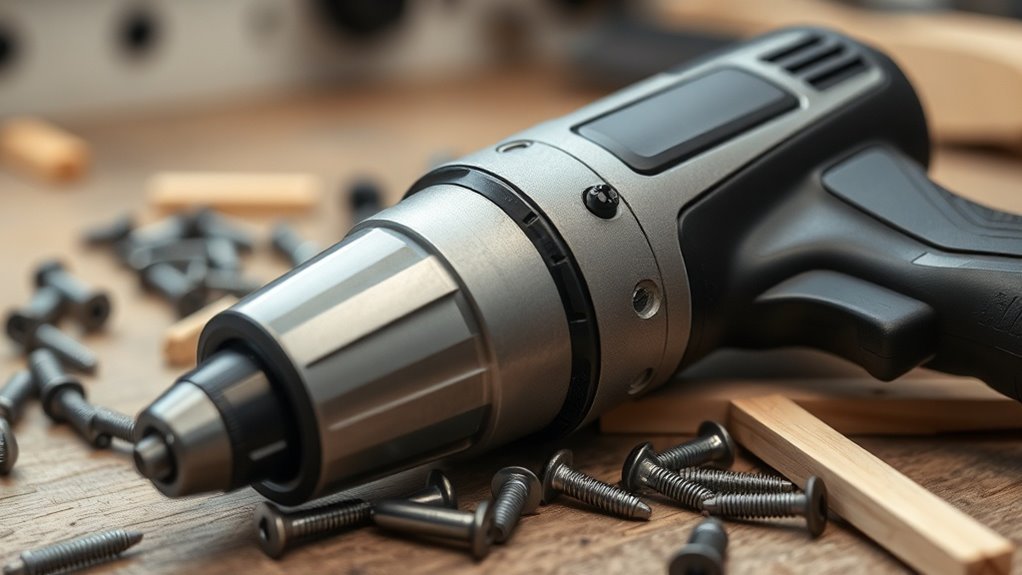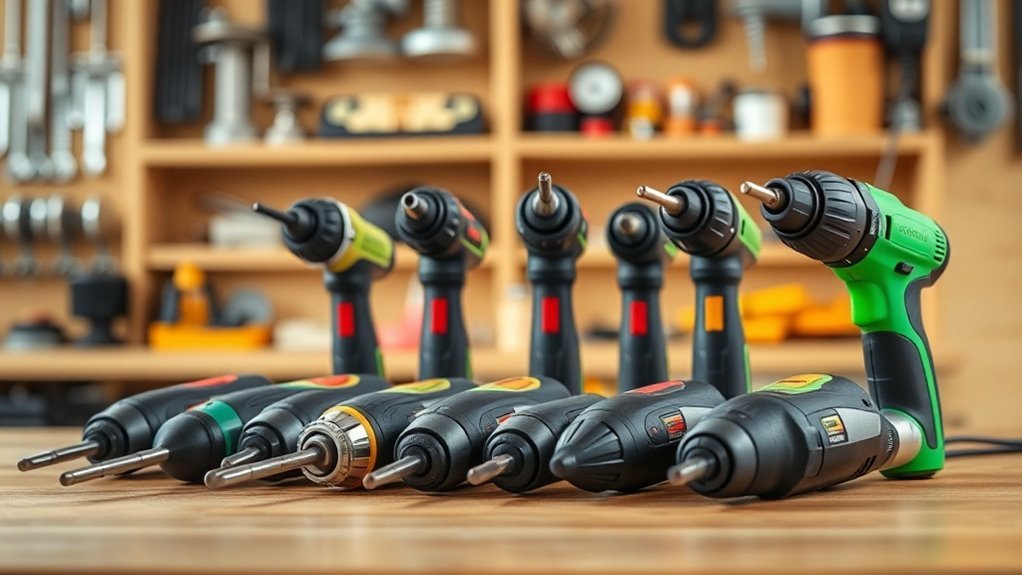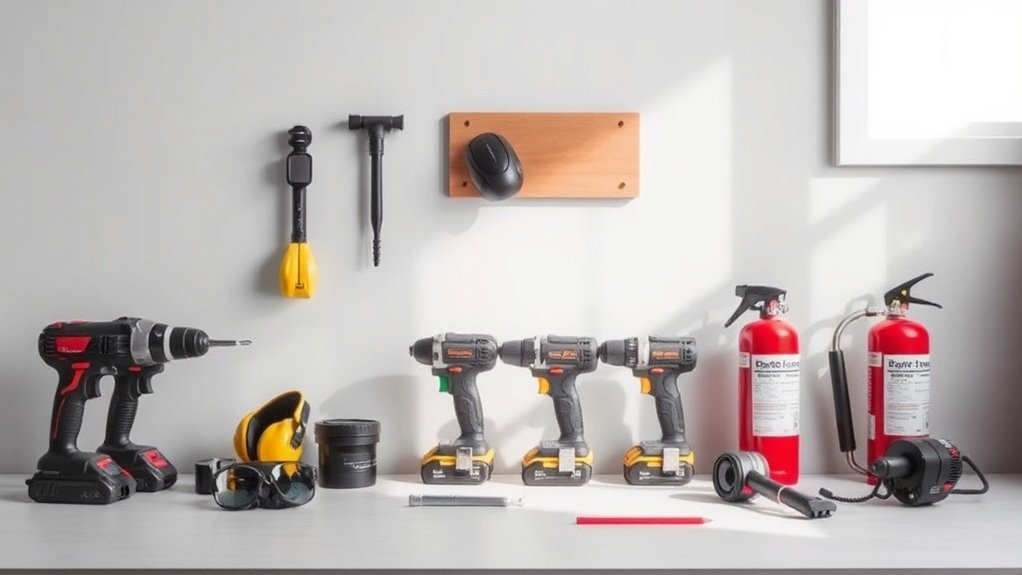Ergonomics in Power Tools: Why Handle Design Matters
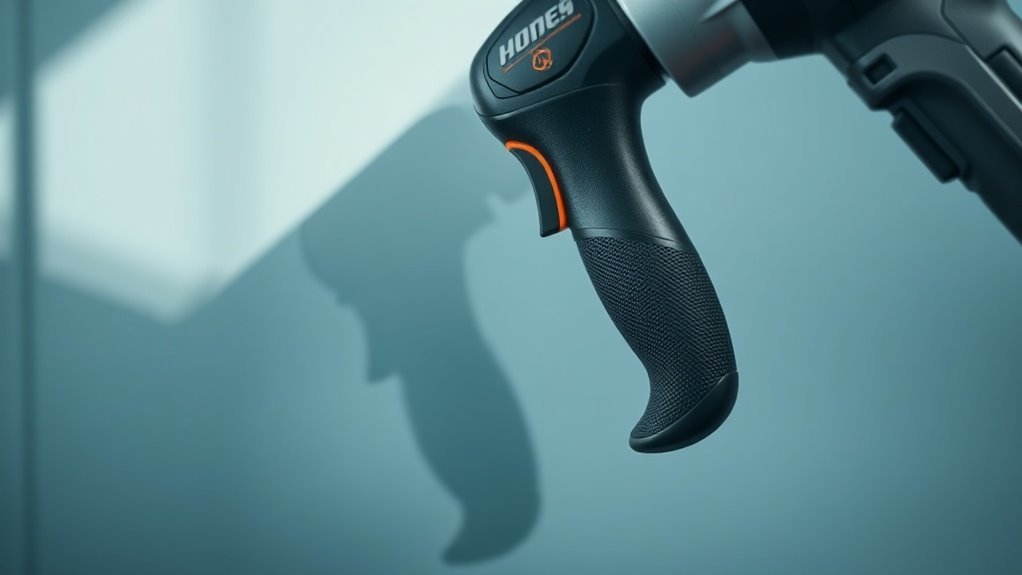
When using power tools, the design of the handle is essential for your comfort and safety. A well-designed handle can reduce strain, enhance grip, and improve control, ensuring you can work efficiently without fatigue. Factors like shape, size, material, and texture all contribute to how well you can manage the tool. With the right ergonomic features, you can minimize the risk of injuries and boost productivity. Explore more about how these elements work together to enhance your experience.
Key Takeaways
- Ergonomic handle design reduces strain and enhances user comfort, promoting longer and more efficient tool use.
- Proper handle shape and dimensions ensure a natural grip, minimizing discomfort and risk of injury during prolonged tasks.
- Grip texture and material choices provide improved control and durability, essential for maintaining safety during operation.
- Balanced weight distribution and vibration dampening mechanisms significantly reduce fatigue and strain on hands during use.
- Customizable handles accommodate different hand sizes and grip styles, enhancing precision and reducing slippage for safer operations.
Understanding Ergonomics in Tool Design
When you think about power tools, it’s easy to overlook how essential ergonomics are in their design.
Ergonomics focuses on how tools interact with your body, aiming to reduce strain and improve comfort during use. A well-designed power tool fits your hand and aligns with your movements, making tasks feel more manageable. This not only enhances efficiency but also minimizes the risk of repetitive strain injuries.
You’ll find that ergonomic designs often include features like soft grips or adjustable handles, which cater to various hand sizes and preferences. Additionally, features such as weight distribution are crucial in preventing user fatigue during prolonged use.
Prioritizing ergonomics can greatly boost your productivity and enjoyment, allowing you to tackle projects with greater ease, so you can focus more on the task and less on discomfort.
The Impact of Handle Shape on Comfort
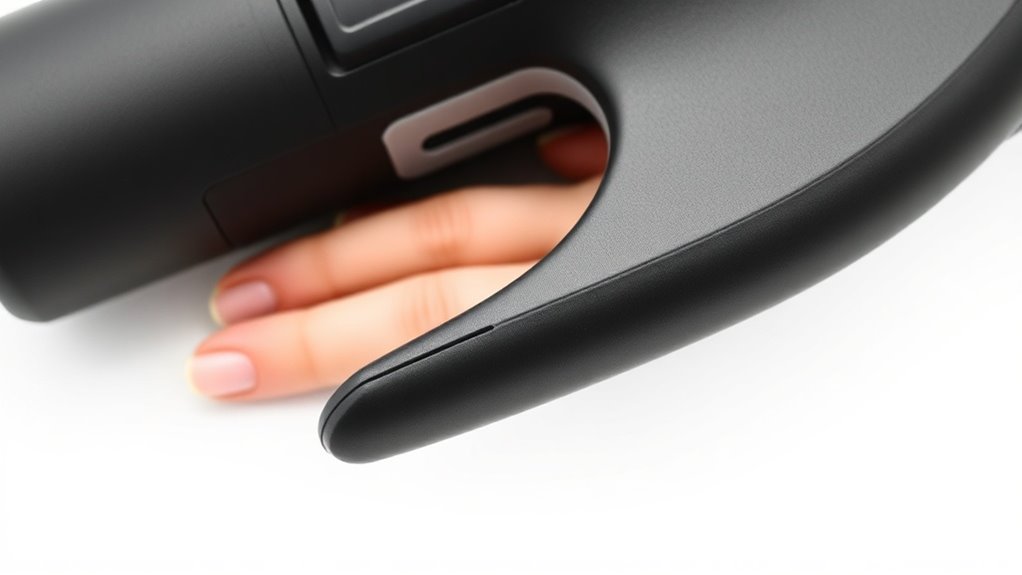
How does the shape of a handle affect your comfort during prolonged use? The contours and angles of a handle can greatly influence how you feel while utilizing a power tool.
The contours and angles of a handle significantly impact your comfort and performance during prolonged use of power tools.
When a handle fits your grip naturally, it minimizes strain on your hands and wrists, allowing you to work longer without fatigue. A well-designed handle promotes proper alignment, reducing the risk of repetitive stress injuries.
If a handle is too flat or oddly shaped, you might find your grip slipping or becoming uncomfortable, leading to distractions and potential safety hazards.
Ultimately, selecting tools with ergonomically designed handles can make a noticeable difference in your overall comfort and productivity during tasks, ensuring you stay focused on the job at hand. Moreover, incorporating key ergonomic principles in tool design can significantly enhance user experience and safety.
Material Choices: Balancing Grip and Durability
When choosing materials for power tools, you’ve got to take into account how grip texture affects comfort and control. Don’t forget about how different materials impact longevity and how they can shift the weight distribution of the tool in your hand. Striking the right balance is key to achieving ideal performance and user satisfaction. Additionally, using proper storage containers can further enhance the longevity of your tools by protecting them from damage when not in use.
Grip Texture Importance
Choosing the right grip texture for power tools is essential; it can greatly impact your control and comfort during use. A well-designed grip can reduce slippage, allowing you to maintain a secure hold even during intense tasks.
Textures like rubberized or knurled surfaces provide enhanced friction, ensuring your hands won’t slide, particularly when you’re working in challenging conditions.
Smooth grips might feel comfortable at first, but they often lack the grip needed for prolonged use. Remember, it’s all about finding the right balance between comfort and functionality—designing for both your grip and how durable the texture is will help you get the most out of your tools.
Material Longevity Considerations
Material longevity plays an essential role in the overall performance of power tools.
When choosing power tools, you need to take into account the materials used in their handles. Durable materials not only enhance the tool’s lifespan but also contribute to a secure grip. Thermoplastics, rubber composites, and metal alloys can provide both strength and comfort.
You’re balancing durability with grip, and it’s vital to select materials that can withstand repeated use while feeling good in your hand. A poorly designed handle made from inferior materials may wear out quickly, affecting your tool’s reliability and safety.
Ultimately, making informed decisions about handle materials guarantees you get the most from your power tools, enhancing both performance and your working experience.
Weight Distribution Effects
The effectiveness of power tools goes beyond just durable handle materials; it also hinges on how weight is distributed throughout the tool. When you’re using a power tool, the balance affects how comfortable it feels during operation.
A tool that’s too heavy at one end can lead to fatigue and even strain. By choosing materials that strategically balance weight, manufacturers can enhance your grip and overall control. Lightweight composites might offer less durability but can greatly improve handling.
On the other hand, heavier materials can increase stability but may lead to discomfort over prolonged use. Ultimately, finding the right balance between durability and weight guarantees you can work effectively without compromising safety or comfort.
Size Matters: Finding the Right Handle Dimensions
When it comes to using power tools, the grip and dimensions of the handle can make all the difference.
You’ll find that handle shape variations and ideal lengths cater to different hand sizes and working conditions.
Getting this right not only enhances comfort but also helps improve your overall efficiency and safety.
Importance of Handle Grip
Finding the right handle grip is essential for comfortable and effective tool use. A proper grip allows you to maintain control, reduces fatigue, and enhances precision.
If the handle is too small, your hand may cramp, causing discomfort during prolonged tasks. On the other hand, a handle that’s too large can lead to a lack of control, increasing the risk of accidents.
It’s important to assess not just the size, but also the material, as a textured surface can improve grip security. When choosing a tool, think about your hand size and how it fits the handle.
It should feel natural, promoting a relaxed hand position to keep you focused on the task at hand. Comfort truly makes a difference in efficiency.
Handle Shape Variations
Choosing the right handle grip is just the beginning; handle shape also plays a significant role in tool ergonomics. You’ll find that different shapes can affect comfort and control in unique ways.
For instance, a contoured or angled design might fit your hand better, reducing strain during prolonged use. Consider your finger positioning as well; a wider handle can distribute pressure more evenly, which helps prevent fatigue.
Meanwhile, a flared shape at the base can prevent your hand from slipping during operation. Experimenting with various shapes can help you discover what feels right, allowing for a more enjoyable and productive experience.
Ultimately, the right handle shape enhances your connection to the tool, improving your performance and safety.
Ideal Handle Length
The ideal handle length in power tools can make a world of difference in your comfort and control. If the handle’s too short, you might struggle with stability and grip, leading to fatigue. Conversely, a handle that’s too long can hinder maneuverability and precision.
To find the right dimensions, consider your hand size and working style. You should be able to hold the tool comfortably, allowing for a natural wrist position. Try different models and see how they feel during operation.
The right length enhances your dexterity and reduces strain, making your tasks easier and more efficient. In the end, it’s about finding that perfect balance, ensuring you can work with confidence and ease.
The Role of Grip Texture in Preventing Slips
When it comes to power tools, having a reliable grip is essential for ensuring safety and control during use. One of the critical factors contributing to that grip is texture.
A well-designed handle with appropriate grip texture can greatly reduce the chances of slips, especially in high-stress situations. You’ll want a surface that feels secure under your fingers, whether it’s rubberized, patterned, or molded to fit your hand.
These textured surfaces enhance friction, making it easier to maintain control even when your hands are sweaty or oily. In short, choosing tools with the right grip texture not only boosts your confidence but also helps prevent accidents, ensuring you can work efficiently without the anxiety of losing your hold. Additionally, user feedback plays an essential role in optimizing grip design to meet the needs of different tool users.
Vibration Dampening: Protecting Your Hands
Vibration dampening is an essential feature in power tools that can greatly reduce hand fatigue and long-term injury risk. When you use tools that produce excessive vibration, your hands experience discomfort and strain, which can lead to conditions like hand-arm vibration syndrome.
Choosing tools with effective vibration dampening mechanisms guarantees you’re less likely to suffer from these issues over time. Look for power tools equipped with materials or design features that absorb vibrations, such as rubber grips and specialized mounting systems. Additionally, always remember to wear appropriate safety gear to further protect yourself while operating power tools.
These enhancements not only improve comfort during use but also enhance overall control. Your hands deserve protection, so investing in quality tools with vibration dampening will pay off in the long run, keeping you safe and productive.
Customization: Adapting Handles for Individual Needs
Power tool ergonomics doesn’t stop at vibration dampening; handle customization plays an essential role in ensuring comfort and efficacy during use. When tools are tailored to fit your grip, you can reduce fatigue and enhance precision. Factors like hand size, grip style, and specific tasks make a significant difference in your experience. Additionally, the increased efficiency of brushless motors complements ergonomic designs by providing smoother operation, allowing for better control during tasks.
| Customization Features | Benefits |
|---|---|
| Adjustable Handle Length | Accommodates different users |
| Textured Grip | Reduces slippage |
| Contoured Shape | Fits natural hand position |
| Soft Padding | Minimizes pressure points |
| Variable Angles | Enhances maneuverability |
Safety Features in Ergonomic Handle Design
When choosing power tools, think about how safety features in ergonomic handle design can enhance your experience.
A user-friendly grip helps you maintain control, while vibration dampening technology reduces strain on your hands.
These elements not only make your tasks easier but also protect you from long-term injuries.
User-Friendly Grip
Although many might overlook it, the design of a power tool’s grip plays an essential role in user safety and comfort. A user-friendly grip guarantees that you can hold the tool firmly without excessive strain on your hands.
When you’re working, a textured surface prevents slipping, giving you better control over the tool’s movements. Additionally, ergonomic shapes can help distribute pressure evenly, reducing the risk of fatigue during long tasks.
A well-designed grip also accommodates various hand sizes, making the tool accessible for everyone. Consider tools that allow for multiple hand positions, as they help you adjust your grip to suit the task at hand.
Vibration Dampening Technology
Many tools with user-friendly grips also incorporate vibration dampening technology to enhance safety and comfort further.
It’s essential to minimize vibrations as they can lead to fatigue or even injuries over time.
Here’s what you should look for in power tools:
- Anti-Vibration Systems: Mechanisms that absorb and reduce vibrations during operation.
- Composite Handle Materials: Strong yet flexible materials that diffuse shock effectively.
- Isolated Handgrips: Designs that prevent vibration transfer to your hands.
- Weight Distribution: Balanced tools that lessen the force transmitted during use.
The Link Between Handle Design and Productivity
The design of power tool handles plays an essential role in your overall productivity. When handles are ergonomically shaped, they fit comfortably in your hand, reducing fatigue during extended use.
This comfort allows you to maintain focus on the task rather than feeling strain, enabling you to work faster and more efficiently. If a handle provides a secure grip, you can exert better control over the tool, resulting in improved accuracy and reduced errors.
Additionally, a well-designed handle can minimize vibrations, further enhancing your comfort and performance. Ultimately, investing in tools with thoughtfully crafted handles not only boosts your productivity but also contributes to your long-term health, allowing you to tackle tasks with confidence and ease.
Future Trends in Ergonomics for Power Tools
As the importance of handle design in enhancing productivity becomes more evident, innovations in ergonomics for power tools are set to evolve remarkably.
Here’s what you can expect in the coming years:
- Adaptive Grip Technologies: Expect tools that automatically adjust grip size and shape to fit your hand comfortably.
- Smart Feedback Mechanisms: Sensors that provide real-time data on your grip pressure and posture will help you maintain ideal ergonomics.
- Lightweight Materials: Manufacturers are likely to explore new materials that reduce tool weight while maintaining durability.
- Customizable Designs: Tools will offer adjustable components, allowing you to change handle configurations based on specific tasks.
These advancements will greatly enhance comfort, performance, and overall safety in power tool usage.
Questions
How Does Handle Design Affect Tool Efficiency and Performance?
Handle design directly impacts tool efficiency and performance. When it fits comfortably in your hand, you’ll have better control, reduced fatigue, and enhanced precision, enabling you to work faster and more effectively with less strain.
Are There Specific Regulations for Ergonomic Power Tool Designs?
Yes, there are specific regulations for ergonomic power tool designs, often set by safety organizations. You should always check guidelines from authorities, like ANSI or ISO, to verify tools meet ergonomic standards for better comfort and safety.
Can Poor Handle Design Lead to Long-Term Health Issues?
Absolutely, poor handle design can lead to serious long-term health issues. Imagine your hands aching after a long day’s work; discomfort grows into chronic pain if you ignore ergonomic principles. Don’t let it happen to you.
What Are the Most Common Ergonomic Complaints From Tool Users?
You might notice common complaints like discomfort, hand fatigue, and wrist strain. Users often experience soreness or tingling in fingers, especially after prolonged use, highlighting the importance of comfortable, well-designed tool handles for better user experience.
How Can I Assess if a Power Tool’s Handle Is Ergonomic?
To assess a power tool’s handle, consider how it feels during use. Is it comfortable, does it fit your grip well, and allow easy control? If it does, you’ve likely found an ergonomic design!
Conclusion
So, if you thought power tool handles were just a “grab-and-go” afterthought, think again! The design’s not just about looking pretty; it’s a matter of comfort, safety, and even your productivity. Who knew that a few extra curves or a textured grip could keep you from wrestling your tools? Next time you’re elbow-deep in a project, remember: a poorly designed handle could turn your DIY adventure into a slapstick comedy. Don’t let that happen to you!


